
One of the oldest nations in the world, Armenia is an ancient land covered by endless plethora of historic sites and natural gems. Armenians were the first ethnic group to fully adapt Christianity, consequently, Armenia’s extant churches are among the earliest anywhere on earth, scattered along its breathtaking mountainous landscape. Modern-day Armenia still recovers from decades of Soviet rule and a bloody conflict with its Azeri neighbors, yet what the country lacks in economic prosperity it certainly makes up for in its people’s exceptional hospitality, spectacular architectural marvels and dramatic wild scenery. We’ve gathered 10 villages and towns, telling the story of this fascinating speck of land.
Surrounded by the Zangezur Mountains, the town of Goris serves as a major gateway to Armenia’s southern provinces and the self-proclaimed republic of Nagorno-Karabakh, linked to many of the region’s small villages by a frequent bus service, nevertheless, even if you opt to spend here only a couple of hours as a stopover, there are still plenty of sites to visit.
The town itself is blessed with hospitable vibes despite being exceedingly mundane, offering its visitors decent dining options and handful of public buildings to behold at, most notably St. Grigor Lusavorich Church and Goris city-hall, both covered by massive silvery stones, proudly showcasing a traditional Armenian architecture, overwhelmingly standing out in a town dominated by a soviet-era housing.
Jutting out from the town’s hillside, Goris’s cave dwellings are by far its most remarkable highlight, consisting of dozen of volcanic chimneys, the bulk of which have artificially carved caves dating back centuries ago, still used for religious rituals or as a cattle shelter. Interestingly, another cluster of rock formations is found few kilometers away, near the village of Khndzoresk, where dozens of craggy pinnacles are pierced with man-made caves, some were even inhabited just until the 1950’s whereas the hermitage and two churches are still religiously active. The Khndzoresk cave complex spans over a valley, interconnected by a newly constructed hanging bridge overlooking the gorge, a popular attraction by its own right.
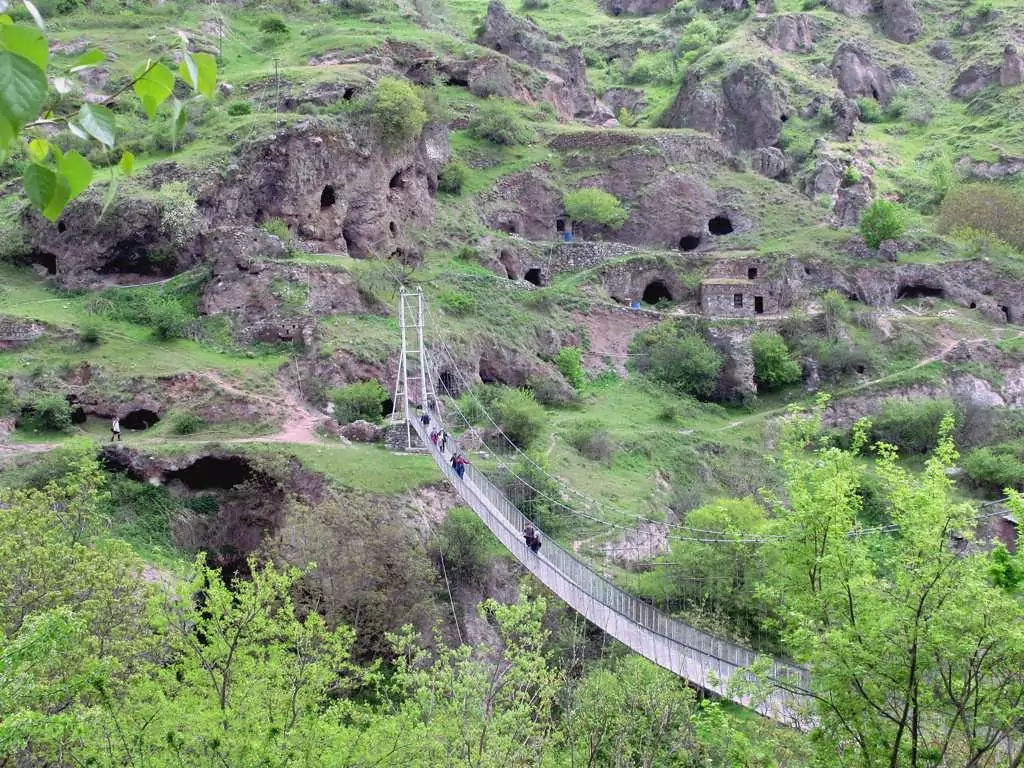
Khndzoresk cave complex and the hanging bridge
photography by: David Stanley
Bordering the Islamic republic of Iran, the town of Meghri is one of Armenia’s southernmost settlements, a popular stop for the frequent international border-crossers making their way to Iran and vice-versa.
While this border town might be modest in size, it’s far from a dull place, having a surprisingly interesting old quarter with many alleys to stroll in, culminating in the 17th century church of Surb Astvatsatsin, embellished by graceful Armenian-style frescos.
Sandwiched between two mountain ranges and bisected by a river, Meghri is a product of its own dramatic topography, literally dictating its urban sprawl throughout the centuries, as residential housing sprung up in lower fertile areas whereas churches and fortified military buildings were constructed upwards, one of which is the 17th century Meghri Fortress, rewarding any hiker who climbs uphill with breathtaking panoramic views of the town and its surrounding brownish mountains.
If you’re planning to stay in Meghri for more than a day, then consider visiting the nearby Arevik National Park, one of the largest protected areas in Armenia. Home to 150 species of butterflies, 180 species of birds, brown bears and even endangered leopards according to some eyewitnesses, the park is traversed by hiking trails, heading to several secluded waterfalls and creeks through its beautifully preserved semi-desert landscape.
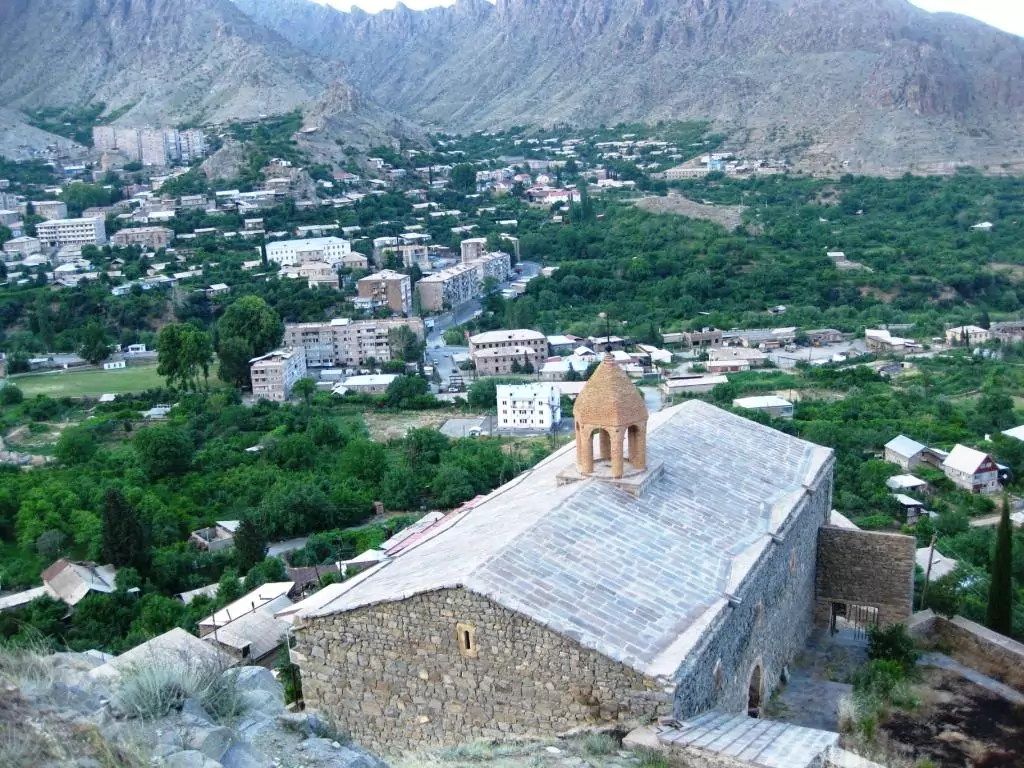
Surp Hovhannes overlooking the town of Meghri
photography by: Գարվիք
Roughly one hour drive from Goris lies the village of Tatev, one of the most culturally rich rural communities in Armenia, providing visitors with a plethora of interesting things to see and experience.
Almost synonymous with the village itself, Tatev Monastery is by far the most renowned sight to explore within Tatev. Originally built in the 8th century, Tatevi vank, as it’s locally known, is a monastic complex, consists of three churches and several other auxiliary buildings, dramatically perches on the edge of a cliff, overlooking a deep gorge.
Due to the region’s strategic location as a continental crossroad, over the centuries different mighty empires took control of it, destroying everything in their path, nevertheless, each devastation was followed by the monastery rebirth, driven by the sheer faith and resilience of Armenians who cherished its enormous contribution to their cultural heritage, echoed by its former role as a major university, attracting scholars from all over the country during medieval times.
Its lack of accessibility due to winding road conditions often resulted in tourists skipping Tatev Monastery altogether, subsequently urged Armenian-born philanthropist, Ruben Vardanyan to fund the construction of the Wings of Tatev in 2010, the longest non-stop double track cable car anywhere in the world, linking the downhill village of Halidzor with Tatev by a mere 12 min ropeway ride, lightly making the way upwards while giving visitors an opportunity to enjoy some spectacular aerial views of the gorge beneath.
The area around Tatev has plenty of interesting sites to explore beside the monastery, the awesome Halidzor Observation Deck and the great hermitage of Tatevi Anapat are only two of many reasons to dedicate at least 3 days for this exceptional village, especially if you aren’t too bounded by time.

Tatev Monastery during winter-time
photography by: Simon Desmarais
Nowadays, it’s so often the case where people regard a monastery as a solely religious building, where monks worship god as far away as possible from the hectic life of modern times, deprived from amenities which we take for granted. While it might be closer to the truth at the 21st century, during medieval times monasteries played a much greater role in Armenia, serving as a place for scientific and philosophical research.
The monastery of Gosh, a small village nestled north of Sevan Lake, is perhaps a very extreme case in which a former intellectual epicenter stands almost anonymous, quietly waiting for visitors to rediscover its glorious past. Constructed in the 12th century over the ruins of Nor Ghetik, a more ancient monastery that was destroyed as a result of an earthquake, the current monastic complex was built by the well-renowned medieval Armenian scholar and priest, Mkhitar Gosh, whose achievements are widely revered in the village, consequently renaming it in honor of him.
The Goshvank monastery as it’s called in Armenian consists of several sections, most notably St. Astvatsatsin Church, featuring intricately carved Khachkar stones, leaned against its main façade, standing perpendicularly to yet another exceptional part, a rectangular room made of unpolished raw stones, speculated to be the extant remnants of a 2,000 years old fortress.
While the village is also home to other significant sites, such as Saint Sargis Chapel where the tomb of Mkhitar lies, I would suggest contrasting the history-oriented sightseeing with Gosh Lake, a secluded pristine reservoir surrounded by thick woodland, roughly 45 minute by foot from the village. The walk through the forest trail is an interesting experience in its own right, as some of the trees are embellished with white handkerchiefs as a sign for good fortune, a common practice in Armenia which even predates Christianity.
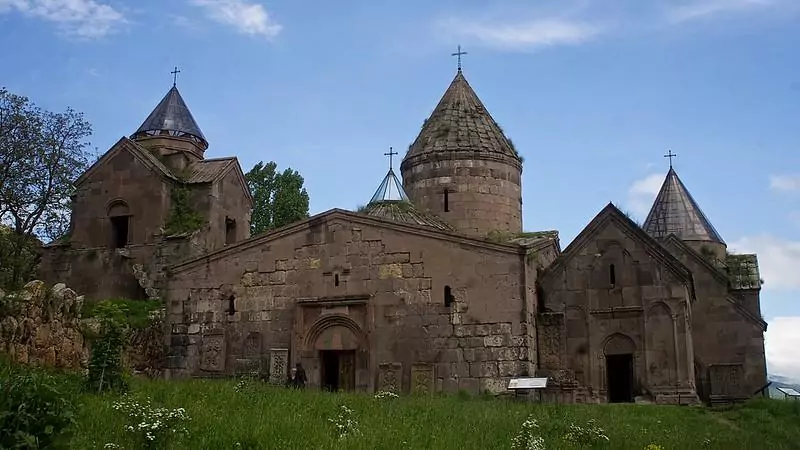
Goshvank’s main facade
photography by: Tony Bowden
The largest urban center in Tavush Province, Ijevan is brimming with authentic town vibes, making it a pleasant day-trip from Yerevan or alternatively a travel base for the plenty of exceptional sites around.
Traversing the town from north to south, Aghstev River is not only Ijevan’s most dominant feature, but also a big source of its charm, as cafés and restaurants, esplanades and a quaint sculpture park are all clustered along the riverfront, gracefully forming an interconnected public space for people to stroll in.
Additionally, the town is home to a big market, known as Ijevan Shuka, offering a large array of local products, ranging from locally grown fruits and vegetables, renowned for their intense flavors and unrestrained sweetness, to a decent dairy section with traditional Armenian cheeses.
Ijevan is surrounded by couple of villages, each with its own unique scenery, nevertheless, the small village of Yenokavan, located few kilometers northwards, outshines all others, as this small rural community overlooks the breathtaking Yenokavan Canyon, a deep gorge with lots of crannies to explore and treehouse lodging suited for nature lovers. Besides the pristine wilderness, echoed by the numerous cascades and creeks, serenely flowing in the middle of a virgin forest, you can also find here an ancient cave named Anapat, famous for its Aztec-style pre-Christian carvings.
If you wish to complement your stay with scrumptious Armenian wines, Ijevan wine factory on the outskirts of town offers tours with tastings of local spirits, whereas the winery store is the perfect place to find a memorable souvenir or a gift to bring back home.
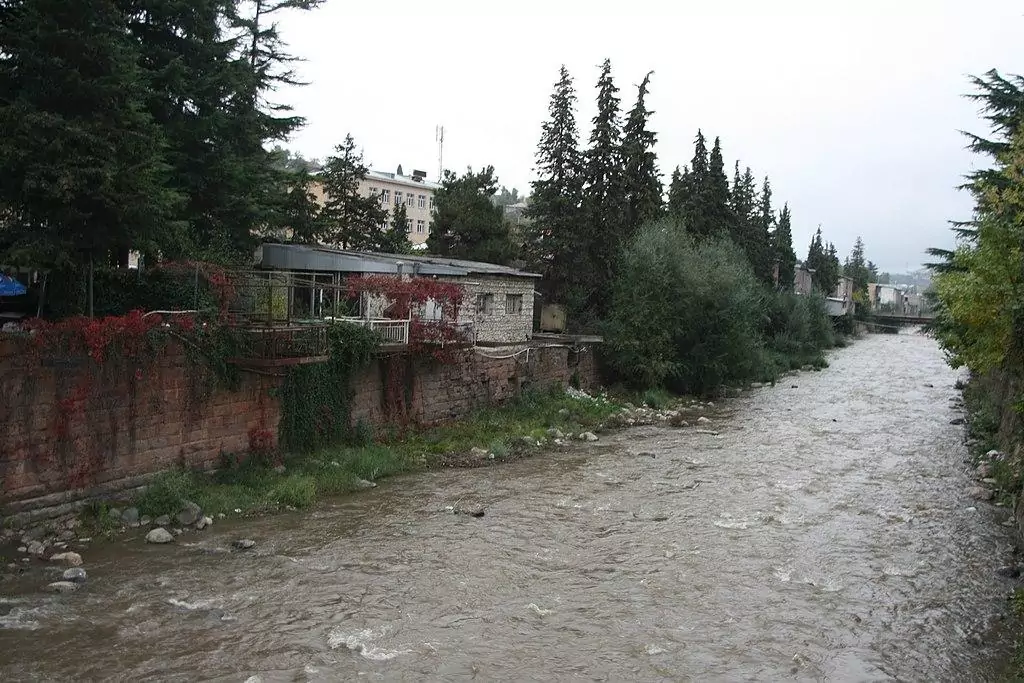
Aghstev River flowing through the middle of Ijevan center
photography by: Michal Gorski
Formally a part of Arzakan village, the mountain resort of Aghveran is one of those secluded nooks where people go to thoroughly clean their head, relaxing by simply being cut-off from the overstimulating daily environment, bonding with the abundant nature around. At a roughly one hour drive from Yerevan, Aghveran is easily accessible, yet despite its relative proximity to Armenia’s largest population center, it stays calm and uncrowded throughout the year, practically enjoying the best of both worlds.
Lacking any real streets or center, Aghveran is actually a cluster of privately owned resorts scattered around numerous glades, surrounded by a lush forest, making it a getaway from the hustle and bustle of the capital and also a hot spot among healthy lifestyle enthusiasts, as many resorts offer locally made organic food accompanied by guided outdoor activities in the woodland, all aiming at promoting physical fitness and general well-being.
While hiking in the forest seems like Aghveran’s main attraction and to some extent it is, the resort central location makes it extremely easy to spend couple of hours in other interesting places, one of which is Arzakan thermal springs, renowned for their water’s healing properties, combating a large spectrum of skin diseases and musculoskeletal pain. Furthermore, the two partially ruined monasteries of Neghuts and Ghuki are found in a short driving distance. Consumed by time, both remnants are frequently visited by hikers from the nearby resorts, awed by their co-existence with the surrounding nature, merging into one spectacular entity, somewhat the Armenian version of Ta-Prohm.
Interestingly, during winter time, some of Aghveran’s resorts host ski-addicts drawn to the snowy slopes of nearby Mount Teghenis, whereas Aghveran itself is teeming with snowboarders, enjoying its relatively mild weather.
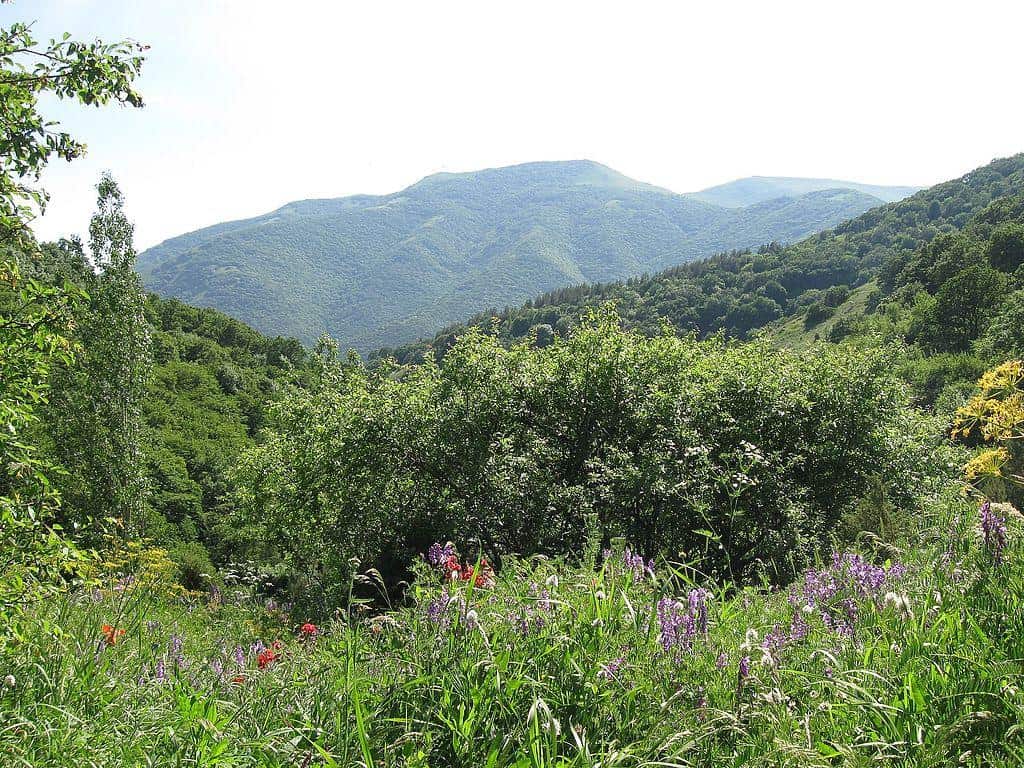
The view of the green scenery from Aghveran
photography by: Valen1988
At first glance Alaverdi might seems like the dullest place imaginable, a dystopian mining town dominated by its Soviet era industrial past, however, if you opt visiting there regardless of its reputation, you’ll find out that this town has much more to offer than what initially meets the eye.
Alaverdi culminated during the Soviet Rule as a prominent industrial center, driven by its gigantic copper mine, yet following the collapse of the USSR, much of the production has halted, leaving the town economically and environmentally crippled. Fortunately, its somewhat grim present is overwhelmingly contrasted by the abundance of historically significant sites around, one of which is the 12th century Sanahin bridge, linking the town’s industrial complex and downhill neighborhoods over the Debed River with the town’s upper parts, albeit, it does entail climbing by foot, while a much easier way upwards is the Soviet-era cable car, originally designated for miners, costing around 0.5 USD for one-way trip.
Once at the top, upper Alaverdi has a plethora of cafes and restaurants, offering an exciting dining experience with breathtaking panoramic views of Debed gorge and the surrounding mountains. After lunch or a small coffee break, it’s more than time to visit the nearby UNESCO world heritage sites of Sanahin and Haghpat, perhaps the medieval equivalent of modern-day prestige war between nations over who will build the world’s tallest skyscraper.
The villages of Sanahin and Haghpat are both home to monastic complexes carrying their name, directly translated as “this is older than the other” and “large wall” respectively, reflecting the centuries-old rivalry between the two villages over regional predominance, resulting in unofficial construction warfare where each monastery tries to outshine the other, but I’ll let you to decide which one prevailed.
The two villages are geographically adjacent, yet whereas Sanahin is accessible by 10 min walk from upper Alaverdi, Haghpat is not directly linked by road, thus requires a minibus-ride (marshrutka), departing from lower Alaverdi’s main station.
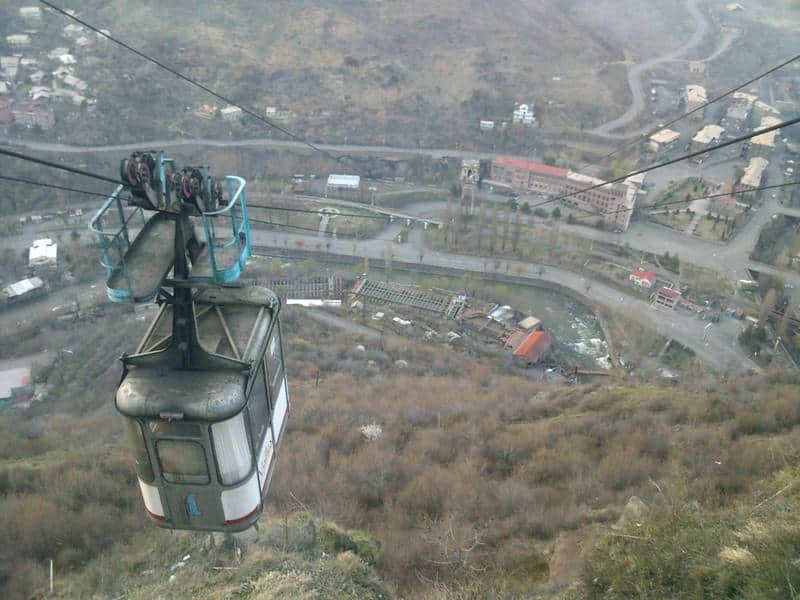
The rusty cable car ascending towards upper Alaverdi
photography by: Kris Duda
The Armenian Version of Borjomi (in Georgia), the spa town of Jermuk is an epicenter of medical tourism, attracting visitors since Soviet times, allured not only by the abundance of resorts and hot springs, but also by its surrounding scenic nature. The town itself is actually a collection of two villages (Dzakhapnyak and Kechut), a defunct airstrip and the northern touristic part, dominated by spa resorts and sanatoriums, interconnected by a network of walkable paths, some of which are facing charming artificial lakes.
As you’ve probably guessed it by now, this town revolves around its many hot-springs and spa resorts, said to possess healing properties for a large array of health issues, yet even if you don’t have any apparent ailment, the relaxing ambience and soft warmness of the spa facilities make Jermuk a favorable getaway for practically everyone.
Besides the numerous spas, an unregulated wild hot-spring, few kilometers west of town, is where you can enjoy an authentic bath of warm and bubbling mineral water with strikingly yellowish colors accompanied by a pinch of sulfuric odors. In fact, Jermuk is quite famous for its mineral water far beyond Armenia, as “Jermuk” labeled bottles containing the precious liquid are sold internationally as a premium product. If you wish to sip some of the mineral rich water, the Mineral-Water Gallery next to Yotnaghbyur Lake is a colonnaded building with pipes connected directly to hot springs, perpetually pumping water into 5 different large vases, with ranging temperatures between 30° to 55°, while each one of them having a distinct color, flavor and smell, aimed at treating various diseases and disorders.
As mentioned, Jermuk is surrounded by many wild marvels, discoverable by hiking, however, for the ones who prefer to enjoy it without much trouble, you’ll be glad to learn that the town is centered around the Arpa river gorge, culminating in a spectacular waterfall, easily observable from a small pedestrian bridge.
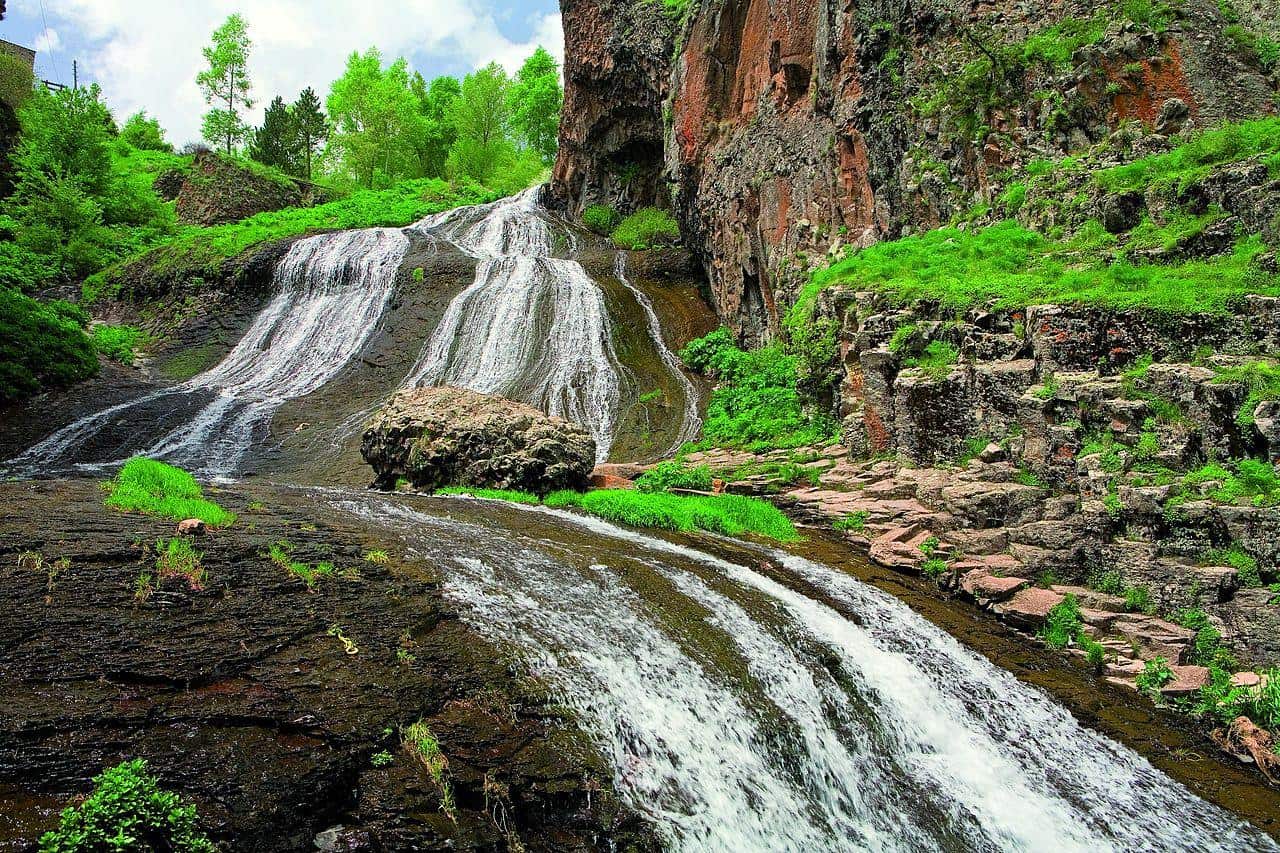
Jermuk Waterfall
photography by: uncrdited/ wikimedia
Merely 12 km from Jermuk lies the village of Herher, flanked by mountain ridges from all directions. Formerly the property of a noble Armenian dynasty known as the Orbelians, this small rural community might not be a tourist hot-spot by its own right, nevertheless, it serves as a gateway to the nearby wonders, most notably the dormant volcano, Mount Vayots.
It won’t be an exaggeration to claim that most people, or at least the travelers among us, have heard at some point about the story of Pompeii, yet little do we know about the city of Moz, which suffered a similar fate. Mount Vayots last eruption in 735 AD and the ensuing earthquake afterwards devastated Moz, leaving only few remnants of one of the most important ancient cities of the region.
Luckily, this giant rocky beast is dormant for over a millennium, making it perfectly safe for exploration. The journey from Herher takes roughly 2-3 hours of mild hiking, relatively ascending only 600 meters, culminating at the 2,581 meters summit, bestowed with epic panoramic vista of the mountainous landscape around, and contrasted by a remarkable inward view of the 125 meter deep crater, once a lava spewing mouth.
Mount Vayotz is by far Herher’s top highlight, however, If you intend to spend here a few more hours or even a day, then consider visiting the artificially made lake south of Herher and the monastic complex of St. Sion on the village’s outskirts, a pair of semi-ruined 8th century churches, accompanied by dozen of scattered Khachkar cross-stones, beautifully embellished with ornamental carvings.

The Khachkar cross stones of Saint Sion Monastery
photography by: Soghomon Matevosyan
Frequently referred to as the Switzerland of Armenia due to its Alpine architecture and landscape, the town of Dilijan is perhaps the most well-preserved settlement in the country, strongly clinging to its authenticity despite being a magnet for relatively high number of domestic and international tourists.
Compared with the country’s other similarly sized towns, Dilijan is far less dominated by soviet style housing, making it an extant epicenter of traditional Armenian architecture, reflected both in the way most buildings are designed and its curvy urban layout, best exemplified in Sharambeyan St, an entirely restored street featuring vernacular buildings.
For the urbex enthusiasts among you, in a forested hill south of Tsaturyan St. stands a dilapidated circular building known as Aghasi Khanjyan’s Summer House, named after the first secretary of the communist party of Armenia, the most prominent political figure of his time who died in mysterious circumstances just before his vacation home was completed, leaving it to slowly decay over the decades, albeit much of it still survived. Found in the same premises is the King of the Forest statue, a figure of mythological king remarkably carved out of a living tree, serving as a local selfie pilgrimage site.
Dilijan is also a short distance away from numerous natural sights, including Dilijan National Park, a large protected area abundant with mineral hot springs, featuring an extensive network of hiking trails, traversing an extremely bio-diverse woodland with over 40 species of mammals, with deer, bears and wolves among the roaming critters. Interestingly, the park is home to couple of monastic complexes, particularly the picturesque Haghartsin Monastery, nestled in a middle of the forest. Due to recent restoration works, Haghartsin is one of the most well-preserved monasteries in Armenia, adorned by many subtle carved ornaments, depicting the regional cultural legacy and the patrons who contributed to its construction.
Another place not be missed is the Clear Lake, or Parz Lich as it’s locally named, a small reservoir east of Dilijan. Located in the heart of a forest, this graceful lake is perfect for an afternoon picnic or simply a relaxing stroll along its banks, whereas the lake’s northern side has an Armenian style restaurant next to a booth offering paddle boat rental, if you wish to experience the water firsthand.
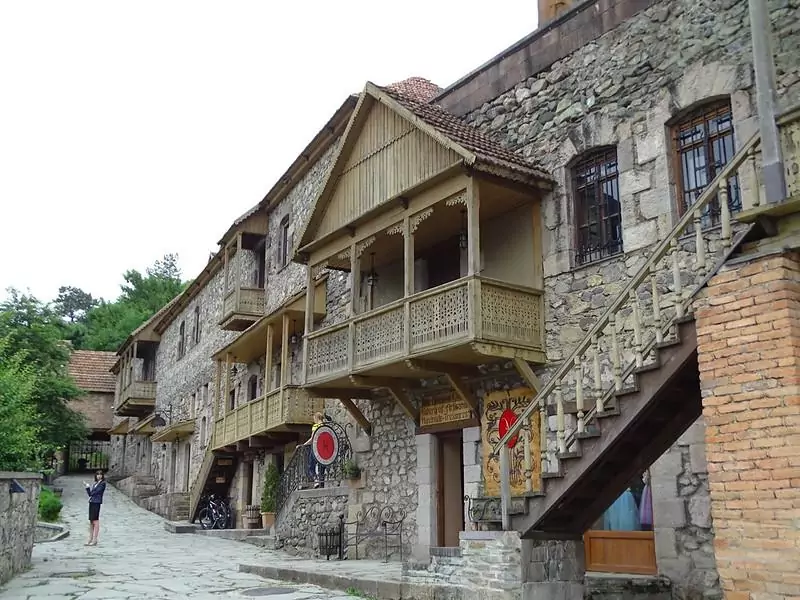
Traditional Armenia architecture at Sharambeyan St.
photography by: Adam Jones